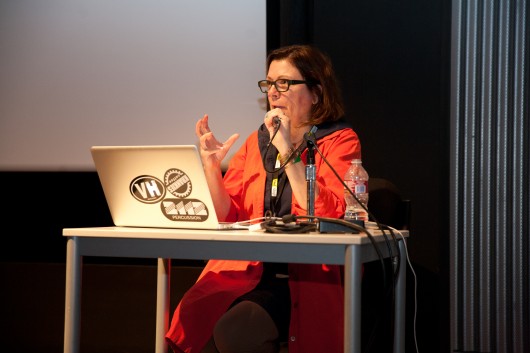What is craft? Denise Gonzales Crisp’s presentation this morning outlined what characteristics should define craft, and how we can be inspired by something seemingly unrelated, like the drums.
Denise defines one characteristic of craft as being enactment. In her presentation, she told a story about her drum instructors resistance to explaining the craft of drumming. However, in his resistance, came a story that, in fact, demonstrated craft. She realized, midway through his conversation, that he was effectively embodying craft. To demonstrate what she meant (and what I mean by stating that), she showed a video about the redesign of the Armani Exchange logo, then compared that video’s instruction to that of the “Party Shuffle”, an instructional video on how to play the drums. The first video, the designers went over the steps of a logo redesign which included such steps as identifying problems with the logo, “drawing” out inter… actually, the video was so boring, and the “designer” felt so cold, most of the audience’s attention (including my own) began to wane. Don’t worry, though, because our attention was regained when she played the video of the drummer. In comparison, the “Party Shuffle” drummer had lots of energy, was fully engaged in what he was doing, and was passionate in his presentation. Additionally, he wasn’t teaching the audience to play anything specific, but rather inspiring them.

Denise Gonzales Crisp
Craft is situational. No longer are we required to work alone. Design and craft is collaborative, which requires us to be engaged with others, in different situations. It’s unusual to work solo.
Craft is articulated. Drummers, as an example, collaborate with one another by using “drum speak”, or their own language based on beats.
Craft is based on legacy. We all draw inspiration from someone else. Denise mentioned that complete originality is a myth. We’re inspired by other people to create works of art, or design.
Craft is flow. Using an example of her own original design, she explained that over time, and with the usage of tools, your designs can take on different shapes and form that weren’t originally planned, or intentional. Her example: at one point in time, she designed a hundred yard garland. It was designed in a 2-dimensional environment, but was meant for 3-dimensional viewing. As she worked it out, through use of space and tools, it began to take on a new form. During these times, embrace the change, and embrace the flow. Although it wasn’t planned, the piece came together to be quite an inspiring work of art.Craft is practice. It’s doing it over and over and over, whatever “it” happens to be. In the case of drumming, it’s practicing on your own, in your own space. This is where one of her more inspirational quotations comes from: Design should be practice more, plan less.
Finally, craft is, above all, personal. Within all of her other lessons, and ideas, craft is only worth doing because it’s personal.






















